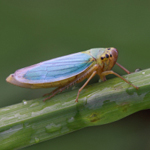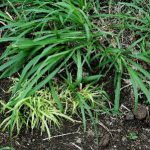Phytoplasma [PHYTO]
Published: February 2nd, 2009
Revised: March 21st, 2023
 Phytoplasmas are bacteria-like organisms without cell walls, discovered in 1967 from the phloem of members of the genus Aster manifesting symptoms of “yellows” disease. They belong to the class Mollicutes, along with mycoplasmas, spiroplasmas and other animal parasites, saprophytes, and insect commensals, and affect more than 700 plant species in all continents, many of which are crops of economic interest, and are associated to significant crop losses. Phytoplasmas are transmitted by phloem-feeding leafhoppers, planthoppers and psyllids of the order Hemiptera. Thus far, there has been no substantial evidence to indicate that phytoplasmal diseases are seed-borne. However, they can be spread by vegetative propagation through cuttings, storage tubers, rhizomes, or bulbs, but cannot be transmitted mechanically by sap inoculation as for many plant viruses.
Phytoplasmas are bacteria-like organisms without cell walls, discovered in 1967 from the phloem of members of the genus Aster manifesting symptoms of “yellows” disease. They belong to the class Mollicutes, along with mycoplasmas, spiroplasmas and other animal parasites, saprophytes, and insect commensals, and affect more than 700 plant species in all continents, many of which are crops of economic interest, and are associated to significant crop losses. Phytoplasmas are transmitted by phloem-feeding leafhoppers, planthoppers and psyllids of the order Hemiptera. Thus far, there has been no substantial evidence to indicate that phytoplasmal diseases are seed-borne. However, they can be spread by vegetative propagation through cuttings, storage tubers, rhizomes, or bulbs, but cannot be transmitted mechanically by sap inoculation as for many plant viruses.
 Phytoplasmas have not yet been cultivated in cell-free medium, making progress in their study slow. As a result, very little is known about their pathogenicity, physiology and biology. Molecular tools, mainly polymerase chain reaction-based assays are the best current approaches for phytoplasma detection, identification and characterization. These methods have enabled preliminary classification of phytoplasmas, several of which have achieved ‘Candidatus’ status (this indicates a provisional taxon status at the species level). To date, there 28 groups of phytoplasmas described and more than 40 subgroups, and 26 ‘Ca. Phytoplasma’ species have been named, forming the core framework of the emerging phytoplasma taxonomy.
Phytoplasmas have not yet been cultivated in cell-free medium, making progress in their study slow. As a result, very little is known about their pathogenicity, physiology and biology. Molecular tools, mainly polymerase chain reaction-based assays are the best current approaches for phytoplasma detection, identification and characterization. These methods have enabled preliminary classification of phytoplasmas, several of which have achieved ‘Candidatus’ status (this indicates a provisional taxon status at the species level). To date, there 28 groups of phytoplasmas described and more than 40 subgroups, and 26 ‘Ca. Phytoplasma’ species have been named, forming the core framework of the emerging phytoplasma taxonomy.
 Phytoplasmas share a two-host cycle involving plants and insect vectors. Having hosts in two kingdoms imposes constraints on the rapidity of its evolution. Phytoplasmas lack several genes that many bacteria such as E. coli need for metabolism. The small genome size associated with phytoplasmas is due to their being the product of reductive evolution from Bacillus/Clostridium ancestors. They have lost 75% or more of their original genes, and this is why they can no longer survive outside of insects or plant phloem. Their minimal genome makes them the simplest known naturally-occurring self-replicating life-form, on the border between living cellular organisms and viruses.
Phytoplasmas share a two-host cycle involving plants and insect vectors. Having hosts in two kingdoms imposes constraints on the rapidity of its evolution. Phytoplasmas lack several genes that many bacteria such as E. coli need for metabolism. The small genome size associated with phytoplasmas is due to their being the product of reductive evolution from Bacillus/Clostridium ancestors. They have lost 75% or more of their original genes, and this is why they can no longer survive outside of insects or plant phloem. Their minimal genome makes them the simplest known naturally-occurring self-replicating life-form, on the border between living cellular organisms and viruses.
Phytoplasma-infected plants exhibit a range of symptoms including yellowing, witches’ broom, proliferation, stunting, flower malformation (virescence and phyllody) and general decline.
Sample collection
- Collect young leaves, young shoots or roots following the procedure given by the Commonwealth Agricultural Bureau’s Global Plant Clinic.
- Dry off any external moisture from leaves and stems with soft paper tissue to avoid crushing or bruising;
- For fleshy or succulent leaves, wrap in layers of absorbent paper;
- All other types of leaves should be sandwiched between two filter papers dampened with 50% glycerol;
- Stems of plants such as sugarcane can be sealed in wax to prevent dehydration of tissue;
- For all preparations above, place in plastic bags, label, and seal;
- Wrap the stem bases of woody plants in a plastic bag containing damp tissue or vermiculite and hold in place with an elastic band. Place the whole sample in a plastic bag, label and seal; and
- Wash root samples thoroughly in sterile distilled water, place in a plastic bag containing damp tissue or vermiculite, label and seal.
Information required
- Prior to sending samples, please contact Dr Arocha-Rosete ([email protected]) to arrange for the specific CFIA (Canadian Food and Inspection Agency) import permit, and to be provided with the sample submission form and the corresponding job number;
- Keep a copy of the sample submission form for your records;
- Once you have received the CFIA import permit, fill out the sample submission form properly, quoting the job number provided;
- Attach to the samples to be shipped to Sporometrics Inc, the CFIA import permit and the sample submission form; and
- Shipment to Sporometrics Inc. should be by airmail, and quoting the address specified at the bottom of the page.
Laboratory code: PHYTO
Service options




